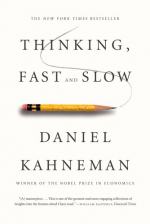
|
| Name: _________________________ | Period: ___________________ |
This quiz consists of 5 multiple choice and 5 short answer questions through Chapters 15 - 18.
Multiple Choice Questions
1. The author notes that in the event that this book were made into a film, what role would System 2 play?
(a) A diva and backstabber.
(b) A leading role while thinking he is a background character.
(c) A minor character that knows it is a minor character.
(d) A supporting character that believes he is the hero.
2. What branch of medicine deals with the incidence, distribution, and possible control of diseases and other health factors?
(a) Psychiatry.
(b) Epidemiology.
(c) Biology.
(d) Psychology.
3. What does the acronym WYSIATI stand for?
(a) What you satisfy is all there is.
(b) What you see is all there is.
(c) What you supply is all there is.
(d) What you seek is all there is.
4. Cognitive strain is defined by the author as being affected by both the current level of effort and what?
(a) Levels of intelligence.
(b) Cognitive Pupillometry.
(c) The probability of future expectations.
(d) The presence of unmet demands.
5. Who wrote Judgment in Managerial Decision Making?
(a) Max Bazerman.
(b) Gary Klein.
(c) John List.
(d) Christopher Hsee.
Short Answer Questions
1. In the example where the author presents two candidates for a college professorship, which choice is favored by intuition?
2. Who wrote the book Sources of Power?
3. What are the subjects in the gorilla study instructed to count in the short film?
4. What is a reliable way to make people believe in falsehoods?
5. Who wrote Strumbling to Happiness?
|
This section contains 262 words (approx. 1 page at 300 words per page) |

|




